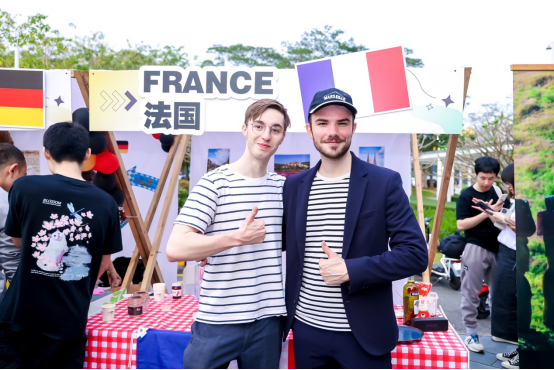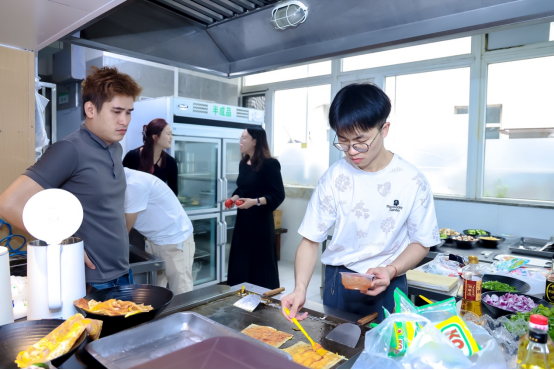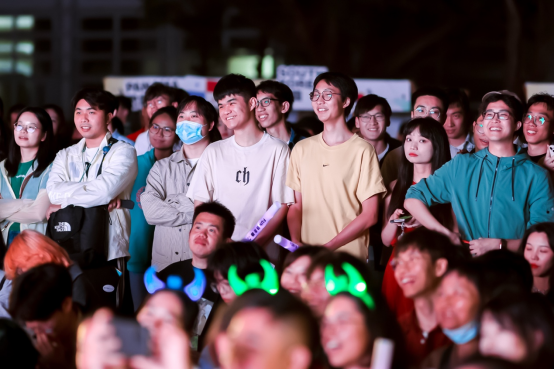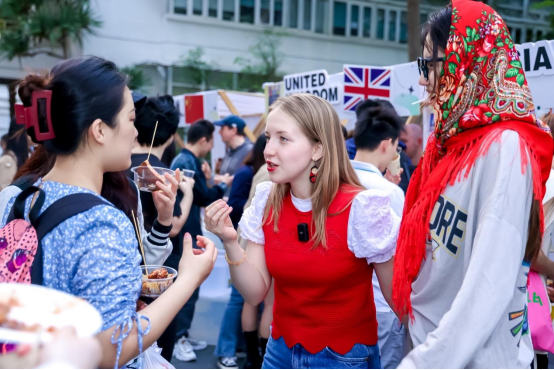To some, the world may be far away to reach. To PKUSZ studentsor any Shenzhener who wants to exploreit, the world is just at their fingertips. Literally.
On April 8, PKUSZ students from all over the world gatheredby the iconic Mirror Lake to celebrate the International Culture Day jointly initiated and organized by the Peking University HSBC Business School (PHBS) International Office, the Student Union and theInternational Student Association.
The PKUSZ-based event, though held inside the University Town, welcomed guests from the society, as “it endeavors to present the world to not only PKUSZ students, but to all who have interests in international exchanges and the cultures around the world,” said Daria Gurianova from the International Student Association who is also a member of the PHBS Art Troupe.

This year’s International Culture Day consists of two major events: the food and drinks exhibition from 4 to 6 pm, and the night show presented by the Art Troupe starting at 7 pm. Not only did the exhibition incorporated specialties from almost 20 different countriesaround the world, but the night show also invited performers and guests from other universities with both Chinese and English songs, making it aninclusive, diversified, and international event that epitomized allenthusiastic and friendly PKUers and their global visions.
Specialties and customs across the globe
In this microcosm of the world’scuisine culture, guests entertained themselves with all varieties of snacks, foods and drinks.While a great majority of the booth owners are from China’s neighbors in Asia, specialties from Italy, Chile and Panama were also within reach.
“I especially like the French baguette with the meat paste on it,” shared Chen Zhan, a first-year graduate student at PHBS in a street interview with the Nanyan News Agency, “and it is new knowledge to me that the baguette is to French people what rice and noodles are to us Chinese, as the booth-owner from France told me just now.”

Indeed,analogies play an effective role in helping people from different cultural backgrounds understand each other, and in that sense, Zhan is not the only one. “My favorite Chinese food is definitely theDongbei Cai (northeastern Chinese cuisine),” said Aleksandre from Georgia, “and the reason is simple – theyare similar in size, not likeGuangdong cuisine which is too little for my appetite.”
Here at the exhibition, not all foods and drinks were given for free. Sometimes, you have to earn it yourself. At the Italian booth, rules were that “you correctly tell the meaning of an Italian gesture randomly assigned to you by a ‘wheel of fortune’, you get a drink,” introduced Roberta, a graduate student at PHBS, from Italy. Many failed, of course, with a lack of knowledge on the customs of other countries and regions. Some succeeded, fortunately,winning themselves a wonderful “sip” of the Italian culture and a round of applause from the surrounding audience.

As the event proceeded, all booths went hard in winning their guests, no matter with hand-made specialties or wines sponsored by commercial corporations specializing in international trade. To Tang Haolan from Shenzhen Yesita Wines, this was a great publicity opportunity to present the wines his company imported from Italy. “And also it was a chance to introduce young people to Italian wine culture,” said Tang who runs his own WeChatvideo account in an online interview, “and I am pretty sure with Roberta there managing the booth, the Italian wine will sure satisfy our guests.”
If sponsorship is the implicit way, thenbuilding a “make-shift restaurant” inside PKUSZ campus is absolutely the explicit way. Mark Ayos, a native Pilipino who runs a Philippine restaurant in Shenzhen’s Nanshan District, decided several days earlier to take the chance to introduce the special cuisine of his home country to PKUSZ students. “The event organizer told me about this and today I took with me some of the most iconic Pilipinofoods to share with our guests from around the world,” said Mark at the event, “and through it I get to know Shenzheners from these different countries and I welcome them to my restaurant!”

In addition tothe 17 booths offering foods and drinks from Asia, Europe and South America, Chinese students alsoorganized four stalls cooking Jiangzhe (Jiangsu & Zhejiang), Chuanyu (Sichuan & Chongqing), Hunan and Dongbei (northeastern China) cuisines respectively. “We had foreign ‘customers’ even when we were cooking inside the canteen at around 3 pm, and they did give positive comments and feedbacks,” said Dong Xin from PHBS who cooked theKaolengmian, a famous northeastern Chinese cuisine, “China is a part of the world, so the International Culture Day should include our delicious Chinese cuisines,” he added.

Songs and dances by the lake
While the best way to win one’s heart is to know theirappetite, songs and dances, as an indispensable part of the “culture”,were not left behind by PKUSZ students. Just one hour after a “taste” of the world, performances at the night show kicked off to provide yet another feast for the audience. Only this time, it appealed to their eyes and ears.

“Diversity is what it is,” said Li Congrong, an audience at the show, “the mood was already lit up by the exhibition as you gotall the snacks and wines, and then the performances just leveled it up. I think everybody enjoyed themselves, and I mean it!”
From what was observed at the show that night, Congrong was not wrong at all. Minutes before the show even started, the first few rows of the seating area were already occupied by kids and their parents coming from outside the University Town.The constant cheers and applauses from off the stage further evidenced its success, as the show went on fromthe passionate Korean danceKill This Love to thesentimental Cantonese songUnder Mount Fuji, from the rhythmicrap soloPray For You to the collaborative group danceShooting Star, and from the quiet Chinese love songThe Dark Night to thevibrant multilingual medley that concluded the memorable night.

But all these did not come from thin air, as the Chinese saying goes: “one second on the stage takes ten years of practice off the stage”. There were countless faces behind the International Culture Day that has brought immense joy and unforgettable cultural exchanging experiences to all who enjoyed themselvesSaturday night.
One month before the day when most of the audience did not even know the thing, preparation within the Art Troupe began. To some, it seems to be a period long enough for preparation; but to Yunke and all other graduate students loaded with heavy academic burden, it wascertainly not. That means, they must speed up.
“Highly efficient, that is the one,” when asked to describe the preparation in one phrase, Cheng Yunke, head of the PHBS Art Troupe answered withan absolute tone, “indeed there was a list of things to do at the beginning, for example, the venue, the personnel, the invitation, and the rehearsal. All of these needed to be finalized one by one for a final deliverable.”

In designing every single performance for the show, Yunke and her colleagues have run into inevitable challenges, and one of them is to present the variety and diversity that is coherent with the theme of the International Culture Day. There, PKUSZ’s friendly neighbors joined in.
“After a round of rehearsal, we felt that diversity is needed for the show, so weturned to second-year students at PHBS who then contacted their friends at Tsinghua University for us,” shared Yunke, “people may not know, but the dance teams of the two universities do have a tradition of collaboration.”
After the THU team, two students from Harbin Institute of Technology Shenzhen (HITSZ) and one fromSouthern University of Science and Technology (SUSTech) joined in, and the dance program was diversified more than ever before. Without letting them down, the danceCrazy Saturday co-presented by PKU, THU, HIT and SUSTech dancers went on to be a hit that night, as it incorporated different dancing elements likeSamba and Cha-Cha, catering foreveryone at the show.

And it was not only the audiences who were greatly amazed by the cooperation in the show, but the dancers themselves were quite satisfied. “We two teams have long been ‘sister teams’, collaborating and competing with each other all the time,” said Mao Rui, leader of the THU Shenzhen International Graduate School Ballroom Dance Team, “the show was great, and I really look forward to more collaboration in the future, no matter who’s the host and who’s the guest.”
Cuisines and talents for the world
The International Culture Day may seem to be one common day, but its impact goes way beyond. “To be happy getting along with each other, to learn from one another, and to integrateoneself into the international society, I think that has to be the world’s future,” said Professor Hai Wen, former Chancellor of PKUSZ and Founding Dean of PHBS who was an invited guest at the event’s opening ceremony, “this is long overdue, and I really enjoyed the joyful atmosphere today.”
As a sign of campus life returning to normalcy with guests from outside the University Town joining in, the International Culture Day has a much deeper meaning than just sharing food and drinks. After all, the cuisine culture is of great importance to intercultural communication in the contemporary world.
“Cuisine is, for sure, one of the ways people are getting together,” Jorge Alfaro from Chile said with excitement, “sometimes people don’t know the language, they have cultural barriers, but cuisine is something that unites everybody.” And for him, that is true. As the only Chilean student here at PKUSZ, Jorge was quite busy at the event. Sometimes, he got too immersed into his introduction of Chile’s uniquegeographic features that he forgot to bring a cup of wine to the guests coming by his booth. “That doesn’t matter. The wine is pretty good, but his story is way better,” agreed by the group of audience circled around the Chilean booth.

Here at PKUSZ campus, cuisine did bring people together. When sharing food, people cannot help but telling the stories behind, be it theorigins, therelated customs, or their personal feelings. And those who were shy of speaking a language different than their native ones were encouraged to communicate with others. There, English the lingua franca became the language that French booth-owners speak with their Chinese guests, that Japanese students speak with their Thai schoolmates, and that South Korean professors speak with their German colleagues.
At one point, this does not seem like to be happening in a Chinese university campus. But the truth is, it is happening and it is happening at PKUSZ, a microcosm of the global village that always embrace inclusiveness and uphold diversity.

“After all, China is bound to be further integrated into the world,” said Professor Hai in an interview with the Nanyan News Agency, “andembracing overseas students and the variety of culture that they represent is part of the effort,” he added.
Adhering to its guiding principle – “International Standards”, the 22-year-old PKUSZ is still on its way to cultivate young talents with a global vision,for the development and common prosperity of the homeland to all, and for the building of a community with a shared future for mankind.

Written by YAN Yuchen